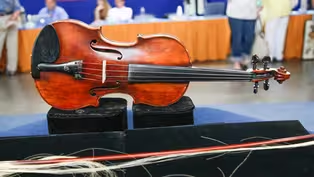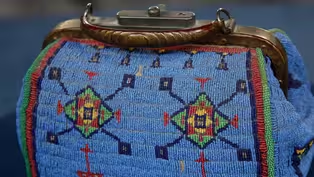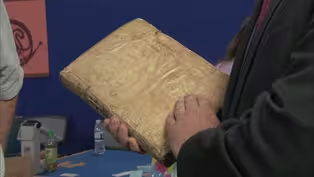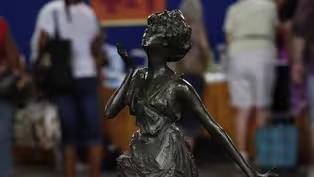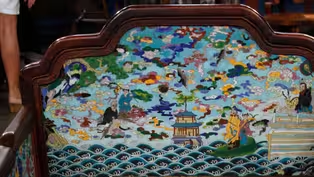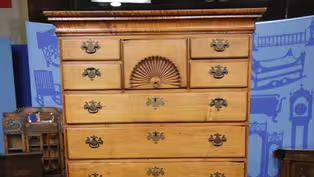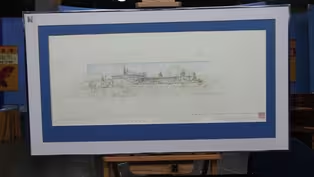
Appraisal: Mughal Indian Reversible Necklace, ca. 1900
Clip: Season 29 Episode 20 | 3m 15sVideo has Closed Captions
Appraisal: Mughal Indian Reversible Necklace, ca. 1900
Check out Peter J. Shemonsky's appraisal of a Mughal Indian reversible necklace, ca. 1900, in Vintage Phoenix, Hour 1.
Problems playing video? | Closed Captioning Feedback
Problems playing video? | Closed Captioning Feedback
Funding for ANTIQUES ROADSHOW is provided by Ancestry and American Cruise Lines. Additional funding is provided by public television viewers.

Appraisal: Mughal Indian Reversible Necklace, ca. 1900
Clip: Season 29 Episode 20 | 3m 15sVideo has Closed Captions
Check out Peter J. Shemonsky's appraisal of a Mughal Indian reversible necklace, ca. 1900, in Vintage Phoenix, Hour 1.
Problems playing video? | Closed Captioning Feedback
How to Watch Antiques Roadshow
Antiques Roadshow is available to stream on pbs.org and the free PBS App, available on iPhone, Apple TV, Android TV, Android smartphones, Amazon Fire TV, Amazon Fire Tablet, Roku, Samsung Smart TV, and Vizio.
Buy Now
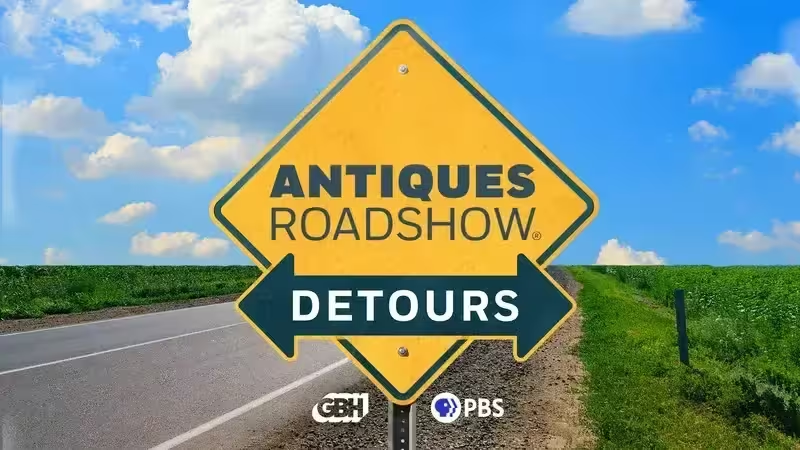
ANTIQUES ROADSHOW DETOURS
Ever wondered what happens to the treasures featured on America’s beloved ANTIQUES ROADSHOW after the cameras leave town? Host Adam Monahan tracks down the juicy afterlives of your favorite finds from PBS’s hit series.Providing Support for PBS.org
Learn Moreabout PBS online sponsorshipGUEST: It actually belonged to a friend of mine's mother.
She lived in California.
And her mother passed away some time ago, and, when they were going through her mother's things, they came across a number of items-- this, some, uh, some clothing and things-- and they passed 'em on to me.
They said, me being the flamboyant person I am... (laughing) APPRAISER: Okay.
GUEST: ...that possibly I might enjoy it, and I just love it.
I don't know anything about it other than it was given to my friend's mother by her next-door neighbor many, many, many years ago.
APPRAISER: The piece is from India.
We might characterize this as what we call Mughal jewelry, although this wasn't a piece owned by the original Mughals from the 17th century.
It's hard to, many times, date these because these types of pieces are still being made today in the same style with the same design motifs.
It's based on the quality of this piece, the level of craftsmanship, and the intricate interweaving of motifs and symbolism that leads me to believe that it is from the late 19th century to the early 20th century.
We have a number of plaques here, and these plaques have enamel on them, predominantly white, red, and green enamel.
We have some spheres that also have the enameling, with the same color motifs.
And we have some pearls here, as well.
Now, these pearls are natural.
That means that they were not cultured.
These pearls probably came out of the Indian Ocean.
If you notice, there are these motifs of tigers in the jungle.
GUEST: Yes.
APPRAISER: And these pendants they're in the shape of what would be a traditional tiger claw.
GUEST: Mm-hmm.
APPRAISER: In Mughal jewelry, sometimes you find the actual tiger claws mounted into the pieces.
The tiger claws themselves were used as a symbol for protection.
So we've got a great combination of symbolism and shape and form in the piece.
Now, the great part, this piece is reversible.
This is actually the back of the necklace.
GUEST: Mm-hmm.
APPRAISER: This is the front side of the necklace.
And on this side, we have a collection of gemstones set into the piece.
The red stones are rubies.
We have topaz, colorless sapphire, emerald, sapphire, diamond, cat's eye, coral, and ruby.
These type of necklaces were, many times, worn during a wedding ceremony.
This would have been part of the dowry that was created for the bride.
But this is a particularly fine example.
Do you have any sense of the, what the value of this would be?
GUEST: Well, when you asked me if I'd consider going on TV, my heart kind of jumped.
And I thought either it's really cheap costume jewelry or it's a really nice piece of jewelry, so... (laughs) I'm hoping it's a really nice piece of jewelry.
APPRAISER: Well, it is a really nice piece of jewelry, and value, for retail replacement, would be between $12,000 and $15,000.
GUEST: Oh, wow.
Oh!
I... Oh!
I'm so exci... APPRAISER: (laughing) That good?
GUEST: That's wonderful!
Thank you.
APPRAISER: It's a beautiful, beautiful example.
GUEST: Oh, wow.
Appraisal: 1956 Maria & Popovi Red Pot
Video has Closed Captions
Clip: S29 Ep20 | 1m 13s | Appraisal: 1956 Maria & Popovi Red Pot (1m 13s)
Appraisal: Amethyst Jewelry Collection
Video has Closed Captions
Clip: S29 Ep20 | 3m 38s | Appraisal: Amethyst Jewelry Collection (3m 38s)
Appraisal: Argand Bronze & Glass Lamp, ca. 1840
Video has Closed Captions
Clip: S29 Ep20 | 46s | Appraisal: Argand Bronze & Glass Lamp, ca. 1840 (46s)
Appraisal: Eugenio Zampighi Paintings, ca. 1900
Video has Closed Captions
Clip: S29 Ep20 | 3m 22s | Appraisal: Eugenio Zampighi Paintings, ca. 1900 (3m 22s)
Appraisal: Folk Art Ship Watercolor & Companion Portraits
Video has Closed Captions
Clip: S29 Ep20 | 34s | Appraisal: Folk Art Ship Watercolor & Companion Portraits (34s)
Appraisal: Gibson L-00 Guitar, ca. 1937
Video has Closed Captions
Clip: S29 Ep20 | 42s | Appraisal: Gibson L-00 Guitar, ca. 1937 (42s)
Appraisal: Japanese Bomb Fragment, ca. 1942
Video has Closed Captions
Clip: S29 Ep20 | 1m 30s | Appraisal: Japanese Bomb Fragment, ca. 1942 (1m 30s)
Appraisal: Late 19th C. Wihelm Schimmel Carvings
Video has Closed Captions
Clip: S29 Ep20 | 1m 42s | Appraisal: Late 19th C. Wihelm Schimmel Carvings (1m 42s)
Appraisal: Massachusetts Game Table, ca. 1805
Video has Closed Captions
Clip: S29 Ep20 | 1m 33s | Appraisal: Massachusetts Game Table, ca. 1805 (1m 33s)
Appraisal: Omega Chronograph, ca. 1937
Video has Closed Captions
Clip: S29 Ep20 | 33s | Appraisal: Omega Chronograph, ca. 1937 (33s)
Appraisal: Steuben Green Jade Glass Lamp, ca. 1925
Video has Closed Captions
Clip: S29 Ep20 | 1m 4s | Appraisal: Steuben Green Jade Glass Lamp, ca. 1925 (1m 4s)
Appraisal: Walnut Shaving Stand, ca. 1875
Video has Closed Captions
Clip: S29 Ep20 | 1m 10s | Appraisal: Walnut Shaving Stand, ca. 1875 (1m 10s)
Appraisal: Gagliano Family Violin & F.N. Voirin Bow
Video has Closed Captions
Clip: S29 Ep20 | 4m 17s | Appraisal: Gagliano Family Violin & F.N. Voirin Bow (4m 17s)
Appraisal: Lakota Sioux Doctor's Bag, ca. 1895
Video has Closed Captions
Clip: S29 Ep20 | 2m 23s | Appraisal: Lakota Sioux Doctor's Bag, ca. 1895 (2m 23s)
Appraisal: 1761 Francisco de Gamboa Book
Video has Closed Captions
Clip: S29 Ep20 | 29s | Appraisal: 1761 Francisco de Gamboa Book (29s)
Appraisal: 1920 Paul Troubetzkoy Bronze Figure
Video has Closed Captions
Clip: S29 Ep20 | 2m 41s | Appraisal: 1920 Paul Troubetzkoy Bronze Figure (2m 41s)
Appraisal: Chinese Wooden Throne & Footstool, ca. 1920
Video has Closed Captions
Clip: S29 Ep20 | 3m 3s | Appraisal: Chinese Wooden Throne & Footstool, ca. 1920 (3m 3s)
Appraisal: Dunlap High Chest of Drawers, ca. 1780
Video has Closed Captions
Clip: S29 Ep20 | 3m 6s | Appraisal: Dunlap High Chest of Drawers, ca. 1780 (3m 6s)
Appraisal: Frank Lloyd Wright Drawing, ca. 1955
Video has Closed Captions
Clip: S29 Ep20 | 2m 11s | Appraisal: Frank Lloyd Wright Drawing, ca. 1955 (2m 11s)
Appraisal: Tiffany Studios Peacock Mirror, ca. 1905
Video has Closed Captions
Clip: S29 Ep20 | 2m 46s | Appraisal: Tiffany Studios Peacock Mirror, ca. 1905 (2m 46s)
Appraisal: Art Deco Lapel Watches
Video has Closed Captions
Clip: S29 Ep20 | 3m 10s | Appraisal: Art Deco Lapel Watches (3m 10s)
Appraisal: Kleinert's Waterproof Baby Pants Display, ca. 1905
Video has Closed Captions
Clip: S29 Ep20 | 2m 28s | Appraisal: Kleinert's Waterproof Baby Pants Display, ca. 1905 (2m 28s)
Appraisal: Walter Anderson Pottery Cat, ca. 1945
Video has Closed Captions
Clip: S29 Ep20 | 2m 8s | Appraisal: Walter Anderson Pottery Cat, ca. 1945 (2m 8s)
Appraisal: 1960 Chuck Close "Man Walking" Oil Painting
Video has Closed Captions
Clip: S29 Ep20 | 3m 17s | Appraisal: 1960 Chuck Close "Man Walking" Oil Painting (3m 17s)
Providing Support for PBS.org
Learn Moreabout PBS online sponsorship
- Home and How To

Hit the road in a classic car for a tour through Great Britain with two antiques experts.













Support for PBS provided by:
Funding for ANTIQUES ROADSHOW is provided by Ancestry and American Cruise Lines. Additional funding is provided by public television viewers.














